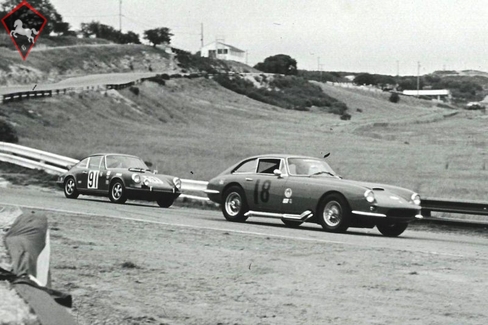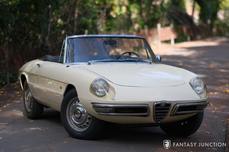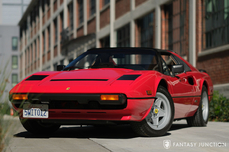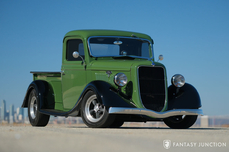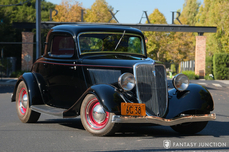Apollo 5000 GT Chevrolet 327 c.i. 8-Cylinder no. FOIO5HA 1966
General description :
1966 Apollo Chevrolet
s/n JN76911011, Engine no. FOIO5HA
Red with Black Leather
Manufactured from 1962 to 1966 in Oakland, California, the Apollo GT married the classic strengths of a beautiful Italian body with the power and reliability of an American powertrain. The Apollo GT was the brainchild of young Californian engineer Milt Brown who wanted to create an American car that could rival the European GT cars of the day. The car was designed by Hungarian engineer and immigrant Frank Reisner who, while on holiday in Turin, established a shop under the name of “Intermeccanica” and went into business producing tuning kits for Simcas, Renaults and Peugeots. Brown met Reisner at the 1960 Monaco grand prix and proposed that Reisner be the coachbuilder for his proposed project. By early 1963, a deal had been made and the first Apollo GT’s went into production. The car’s bodywork was produced in Turin by Intermeccanica and then shipped across the Atlantic to Oakland, California where Brown installed the drivetrain. The car was first styled by a friend of Milt Brown named Ron Plescia. However, the car’s nose was thought to be too long and its rear-visibility too limited. Because of this, Reisner contracted former Bertone stylist Franco Scaglione to revisit the design resulting in the current design.
The car was well received in its day and sold from Brown’s International Motorcars of Oakland with a claimed top speed of 150 mph and a starting price of $6,000. Initially, the car was sold only in two-seat configuration although a later 2+2 prototype was shown at the 1965 New York Auto Show and again the year later bearing the name “Griffith GT”. Brown’s International Motorcars sold a total of 88 cars. Unfortunately, production of the car ended in mid-1964 due to a lack of financing. Several individuals later attempted to bring the car back under the name “Vetta Ventura”. These subsequent efforts proved largely unsuccessful only going on to sell around 19 cars in total. This example, having been sold in 1965, was likely built towards the end of the original round of Apollo production in California.
Milt Brown the designer and builder of the car, remembers this car very well, as it was to be the transition from Buick 215 Alloy V8 to Chevrolet power. He said that GM sent out engineers to make sure the installation of the Corvette motor was properly engineered. He said the finished product was extremely fast, probably because they used the higher horsepower 327 Corvette motor (300hp) which was a vast improvement over the small Buick motor. Just as the car was completed, Buick came out with their 300 cubic inch motor, which did not require the modification of the oil pan, so the decision was made to continue with the Buick motors for the rest of the Apollos built, making this a unique car among a run of about 39 coupes built by the original company.
Dr. Robert Turcios first saw the Apollo used as a pace car at the Laguna Seca Sports Car Races, and decided on the spot to purchase a new one, which he did. Bruce Trenery, the owner of Fantasy Junction, when he was 17 in about 1965, used to trade his Lancia Aurelia for the day with Dr. Turicos for his beautiful silver Apollo, and each would enjoy the other’s car for some hours. Dr. Turicos kept the car for the rest of his life, and his wife, Barbara entrusted Fantasy Junction to sell the car in 2015. Dr. Turicos, found that since he was into Apollos, from the beginning, that cars tended to gravitate to him.
He purchased this Chevrolet-powered Apollo about 1975 in Santa Rosa California. At that time it had lakes pipes down the side(which are not on the car now, but included with the sale, should the new buyer desire them). In 1976, Dr. Turcios was contacted by Walt Disney Productions, to rent the car to them for their new movie “Herbie Goes To Monte Carlo”. The car appeared in the movie driven by American Sports Car Legend Max Balchowsky, best known for building a string of American specials named after another movie personality “Old Yaller”. Documentation of the car in the movie includes letters from Walt Disney Productions to Dr. Turcios, a promotional children’s puzzle of the car, and many still photos taken during the filming of the movie.
The car is also mentioned in “The Milestone Car” number 26 in an article about Apollos by Jack Triplett as the only example with a Corvette motor installed by Brown. Dr. Turcios’ silver car is also featured and discussed.
The body is beautifully straight with excellent gaps throughout. The only corrosion noted was on the bottom of passenger’s door near the drains. It has received a driver quality repaint approximately 40 years ago. The glass is nice throughout car. Chrome is very straight, appears totally original, and is shiny, but there are some minor pits from age. The 250GT Ferrari tail lights are excellent original, as are other lenses. The chrome wire wheels are in good condition, (with wider rears) except the left rear which has considerable chrome deterioration. The tires are almost new. The exhaust appears to be in very good condition.
The interior: The dash remains original and in extremely good condition as to the padding, correct gauges, and various switches. There are a couple of switches added under the dash. The steering wheel is excellent original wood, with the correct Apollo emblem. The headliner is nice, black, and presumably original.
The seats are leather, and may be original and there are some cracks in the driver’s seat. The door panels appear to have been recovered at some point, and while they retain the original handles, cranks and pull handles, the pattern has been changed. The carpeting looks correct and is serviceable, but old.
Engine compartment, retains all the original paint/underseal, correct items like the heater valve, Apollo valve covers and is serviceable but not detailed. Trunk retains its original finish as delivered and appears undisturbed.
The car starts easily, and while the clutch pedal is heavy, the operation of the clutch is smooth. Motor seems tuned reasonably well and delivers great power on acceleration, and one can see why Milt Brown was so impressed with the Corvette motor. Suspension seems tight, and gearbox works well with the stock linkage, syncros seem good up and down. The brake pedal is high and brakes pull the car to a stop in a straight line. Small gauges: oil pressure/oil temp/water temp/amp gauge/fuel gauges seem to work properly, while the tach and speedo at this point are non-op. The wipers function. No noise was apparent from the gearbox or rear end while driving.
Included with the car is a hand written note book starting September 1975, when the car had about 38,000 miles, which goes on to list about every fueling and whatever work was performed. At 39,180 miles, which appears to be about 1976, the motor was rebuilt using 11.5 to one pistons .030 over, crank reground to .010 under, new bearings and the installation of “fuel Injection Heads”, and a crane “Fireball” cam. In 1982 the rear end was rebuilt at 40,057 miles indicated.
This is a wonderful opportunity to acquire a unique large displacement Italian bodied GT from the sixties, that has Milestone status, extremely interesting history, and has been with the same marque specialist for over 40 years in California’s dry climate.
http://fantasyjunction.com/cars/1868-Apollo-GT%20-Chevrolet%20327%20c.i.%208-Cylinder
1966 Apollo 5000 GT Chevrolet 327 c.i. 8-Cylinder no. FOIO5HA is listed sold on ClassicDigest in Emeryville by Fantasy Junction for $89500.
Car Facts
Car type : Car Make : Apollo Model : 5000 GT Model Version : Chevrolet 327 c.i. 8-Cylinder no. FOIO5HA Engine size : 0.0 Model Year : 1966 Location : Emeryville
Sold
Seller Information
Sold
Other cars listed for sale by this dealer
About Apollo
The Apollo is an interesting Italo-American GT car that was produced in the 1960s. It was designed to offer a combination of American power and Italian styling. Regarding its status as a "great" or a "poor man's Ferrari," opinions may vary among automotive enthusiasts. Here are some points to consider:1. Design and Styling: The Apollo had sleek and attractive styling influenced by Italian design. It featured a low-slung profile, elegant lines, and often sported muscular American V8 engines. The design aimed to capture the essence of high-performance European sports cars.
2. Performance: The Apollo's performance was notable, thanks to its powerful engines. It was typically equipped with American V8 engines sourced from companies like Buick and Oldsmobile, which offered significant horsepower and torque. This allowed the Apollo to deliver strong acceleration and impressive top speeds.
3. Build Quality and Development: The Apollo was produced in limited numbers, and there were some challenges with build quality and development. The company faced financial difficulties and lacked the resources of established manufacturers like Ferrari. As a result, some owners experienced reliability issues and the overall refinement of the car could be seen as underdeveloped compared to its competitors.
4. Potential with Better Resources: It is plausible to assume that with better resources, the Apollo could have achieved even greater success. More investment in development, engineering, and production could have addressed the reliability and build quality issues, potentially leading to a more refined and competitive sports car.
Ultimately, whether the Apollo is considered a "great" or a "poor man's Ferrari" is subjective. It had its own unique charm and performance characteristics. While it may not have achieved the same level of recognition or prestige as Ferrari, it still holds a place in automotive history as an interesting and distinctive GT car that combined Italian styling with American power.
The Apollo was produced in a few different models during its production run. Here are some key models, specifications, and estimated production numbers for the Apollo GT:
1. Apollo 3500 GT:
- Engine: 3.5-liter V8 engine sourced from Buick
- Power: Approximately 200 horsepower
- Transmission: 4-speed manual or optional automatic
- Production Numbers: Around 88 Apollo 3500 GTs were produced between 1962 and 1964.
2. Apollo 5000 GT:
- Engine: 5.0-liter V8 engine sourced from Buick
- Power: Approximately 300 horsepower
- Transmission: 3-speed automatic or optional 4-speed manual
- Production Numbers: Approximately 90 Apollo 5000 GTs were produced between 1964 and 1965.
3. Apollo 3500 GT Spider:
- Engine: 3.5-liter V8 engine sourced from Buick
- Power: Approximately 200 horsepower
- Transmission: 4-speed manual or optional automatic
- Production Numbers: Around 11 Apollo 3500 GT Spiders were produced between 1963 and 1964.
4. Apollo 5000 GT Spider:
- Engine: 5.0-liter V8 engine sourced from Buick
- Power: Approximately 300 horsepower
- Transmission: 3-speed automatic or optional 4-speed manual
- Production Numbers: Only a few Apollo 5000 GT Spiders were produced, making the exact number uncertain, but it is estimated to be in the single digits.
Overall, the total production numbers of the Apollo GT are relatively low, with approximately 200-250 cars produced in total across all models. The exact production figures may vary, and it's worth noting that the Apollo went through different ownership and production changes during its production run, which may have influenced the overall numbers. These limited production numbers contribute to the rarity and collectibility of the Apollo GT today.
